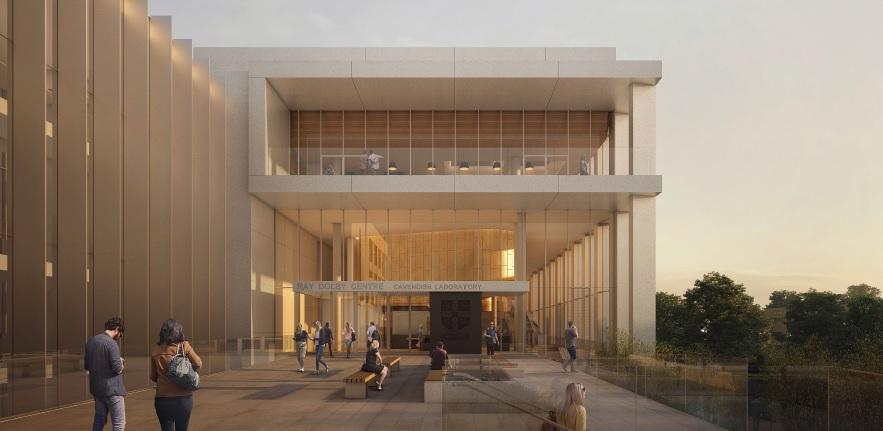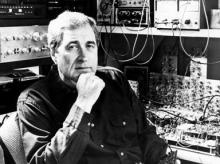
A New Era for Physics at Cambridge
 The Ray Dolby Centre will be the centrepiece of the new Cavendish Laboratory, completing the goals of the ‘Cavendish 3’ project to rehouse the entire Department in state of the art facilities on the West Cambridge site, replacing the ageing buildings opened in 1974. As part of this very large project, the Physics of Medicine building, the Maxwell Centre, the Kavli Centre for Cosmology at Cambridge and the Battcock Centre for Experimental Astrophysics have already been constructed. The Ray Dolby Centre will be purpose-built for our world-leading research programmes, bringing all the remaining research groups in the department together under one roof to encourage collaboration. The new modern building will be a major asset for the University, the city and the country, and will provide National Facilities for all UK Physics departments, sharing equipment and expertise
The Ray Dolby Centre will be the centrepiece of the new Cavendish Laboratory, completing the goals of the ‘Cavendish 3’ project to rehouse the entire Department in state of the art facilities on the West Cambridge site, replacing the ageing buildings opened in 1974. As part of this very large project, the Physics of Medicine building, the Maxwell Centre, the Kavli Centre for Cosmology at Cambridge and the Battcock Centre for Experimental Astrophysics have already been constructed. The Ray Dolby Centre will be purpose-built for our world-leading research programmes, bringing all the remaining research groups in the department together under one roof to encourage collaboration. The new modern building will be a major asset for the University, the city and the country, and will provide National Facilities for all UK Physics departments, sharing equipment and expertiseThe Ray Dolby Centre has been made possible through the generosity of the Dolby family. In addition to their visionary support for the laboratory building itself, the family has also enabled the establishment of a new research group led by a newly-endowed Ray Dolby Professorship in the area of quantum technologies and devices. The naming celebrates the life and career of Dr Ray Dolby, who completed his PhD at the Cavendish before going on to found one of the best-known electronics brands in the world. The UK Government announced a £75 million investment in the Cavendish Laboratory as part of its Spending Review in 2015. The Wolfson Foundation and Humphrey Battcock are among other donors backing the project, together with the University Capital Fund.
The new building, and our new strategic plan, both represent a renaissance of the way in which we will carry out physics research and achieve our research goals. The spirit of adventure and innovation which characterised Ray Dolby’s career will be fostered in the Cavendish tradition, adapted to the new needs of frontier research and to their consequent impact for the benefit of society.
At the heart of the new approach is a more flexible alignment of our activities into research themes, making cross-disciplinary linkages across the traditional group structure. This change of emphasis has been inspired by a number of changes in the nature of contemporary physics research where there is a vast discovery space at the interfaces between traditional areas of physics. With it comes a grouping of equipment into large facilities, well-supported by expert technicians and support staff, and able to cater for the most demanding needs.
In addition to serving as a home for physics research at Cambridge, the Ray Dolby Centre will be a world-class facility for the nation – much of the specialised research equipment in the new building will be made available to other institutions. The new facility is designed to match the most exacting standards of current research, serving the educational needs of future generations of undergraduate and graduate students much more effectively than is possible on our existing site. Capacity for public events has also been incorporated in the design, so that our extensive programme of work with schools, and with the general public, will continue to serve the local population well into the future.
Following a successful planning application for the new facility, Bouygues UK was selected to provide consultancy support to the University’s project team, and construction began in early 2019.
Completion of the building is expected for 2024 and we are looking forward to starting our move into our new home. To help us plan this, we have appointed a migration planning and move consultant. The move planners have started working with the Cavendish Project Team and other groups to map out and design the move timeline and strategic requirements.
Images:
1. Artist's illustration of the entrance of the Ray Dolby Centre. Credit: Jestico + Whiles
2. Ray Dolby surrounded by electronic gear in his San Francisco home sound laboratory on Feb. 22, 1988. Credit: Al Seib/The Los Angeles Times

